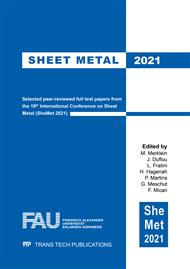[1]
Gude, M., Freund, A.; Vogel, C. & Kupfer, R.: Simulation of a Novel Joining Process for Fiber-Reinforced Thermoplastic Composites and Metallic Components, Mechanics of Composite Materials, 2017, 52, pp.733-740.
DOI: 10.1007/s11029-017-9623-6
Google Scholar
[2]
Gude, M., Vogel, C. & Gröger, B.: Simulation-aided development of a robust thermoclinching joining process for hybrid structures with textile reinforced thermoplastic composites and metallic components, Materialwissenschaft und Werkstofftechnik, 2019, 50, pp.1027-1038.
DOI: 10.1002/mawe.201900036
Google Scholar
[3]
Hufenbach, W.; Frank, A.; Helms, O. & Kupfer, R.: Gestaltung von textilverbundgerechten Fügezonen mit warmgeformten Bolzenlöchern, J Plast Technol, 2010, 6, pp.255-269.
Google Scholar
[4]
Dean, A. & Rolfes, R.: FE modeling and simulation framework for the forming of hybrid metal-composites clinching joints, Thin-Walled Structures, 2018, 133, pp.134-140.
DOI: 10.1016/j.tws.2018.09.034
Google Scholar
[5]
Hirsch, F.; Müller, S.; Machens, M.; Staschko, R.; Fuchs, N.; Kästner, M.: Simulation of self-piercing rivetting processes in fibre reinforced polymers: Material modelling and parameter identification, Journal of Materials Processing Technology, 2017, 241, pp.164-177.
DOI: 10.1016/j.jmatprotec.2016.10.010
Google Scholar
[6]
Vorderbrüggen, J.; Gröger, B.; Kupfer, R.; Hoog, A.; Gude, M. & Meschut, G.: Phenomena of forming and failure in joining hybrid structures–Experimental and numerical studies of clinching thermoplastic composites and metal, AIP Conference Proceedings, 2019, 2113, 050016.
DOI: 10.1063/1.5112580
Google Scholar
[7]
Schürmann, H.: Konstruieren mit Faser-Kunststoff-Verbunden, Springer-Verlag, (2007).
DOI: 10.1007/978-3-540-72190-1
Google Scholar
[8]
Tabatabaei, S.; Lomov, S. & Verpoest, I.: Assessment of embedded element technique in meso-FE modelling of fibre reinforced composites, Composite Structures, 2014, 107, pp.436-446.
DOI: 10.1016/j.compstruct.2013.08.020
Google Scholar
[9]
Dassault Systèmes: Abaqus 2016 Online Documentation, (2015).
Google Scholar
[10]
Tabatabaei, S. & Lomov, S. V.: Eliminating the volume redundancy of embedded elements and yarn interpenetrations in meso-finite element modelling of textile composites, Computers & Structures, 2015, 152, p.142 – 154.
DOI: 10.1016/j.compstruc.2015.02.014
Google Scholar


